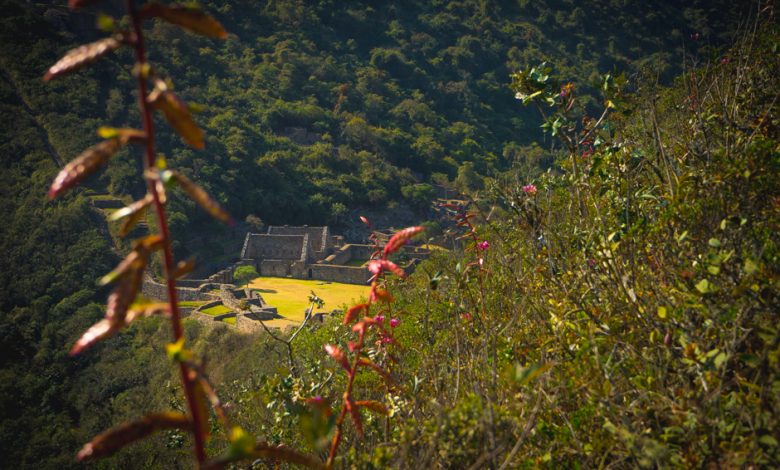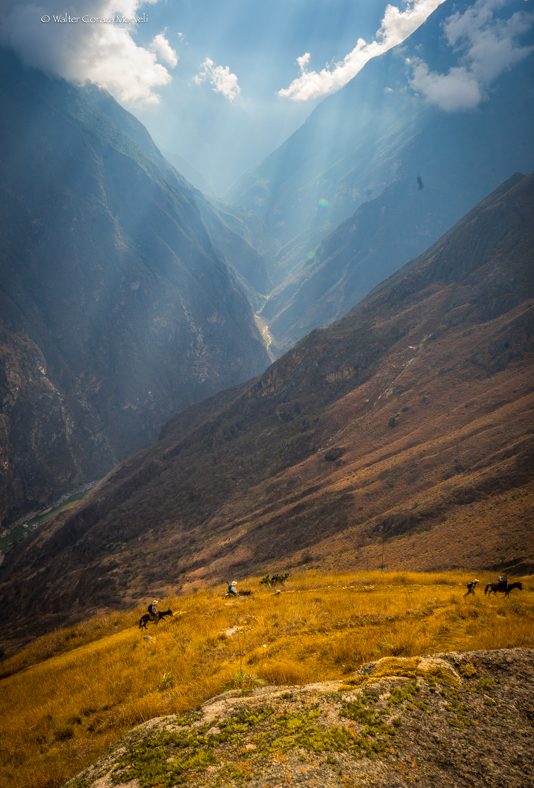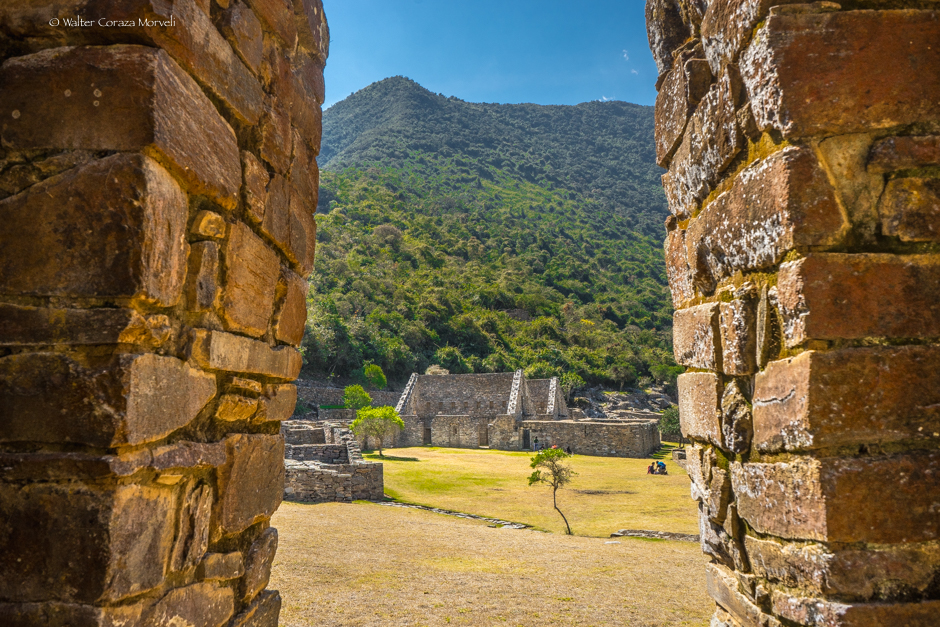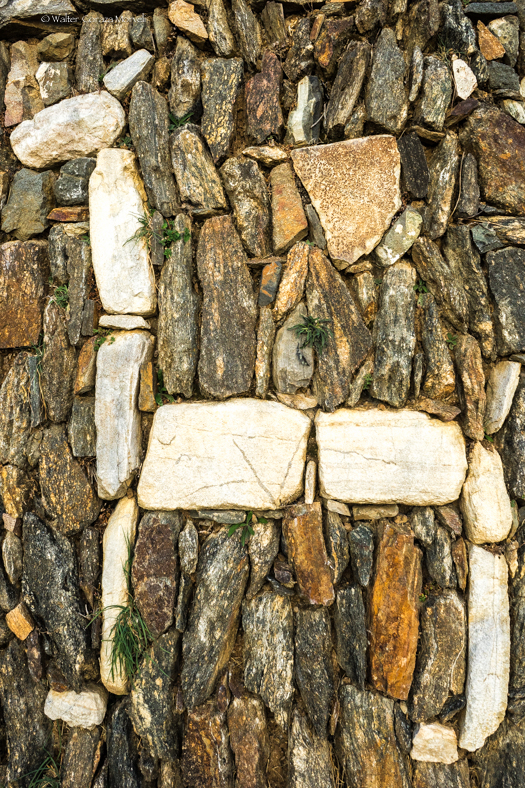The Wonders of the Trek to Choquequirao

During this long holiday for fiestas patrias that began the 28th and ended the 31st of July, we visited the cradle of Inca greatness, better known as Choquequirao. Locals call it The Golden Cradle.
Walter, Adrian and I left Cusco Thursday at 3 pm in a minivan that departs from Arco Pata Streeet. It took four hours for us to get to the small village of Cachora located on the Apurimac River. There we began walking. It was around 7:30 pm and we carried our tent, lanterns, and out backpacks that felt light. While we walked in the dark, the stars looked happy and showed us the amazing milky way. From the side of the road we heard birds while the dark vegetation kept us company. A little tired we decided to camp around 10 pm in a zone for camps called Capuliyoc. We rested until 4 am and left from there one again following the trail and its well-placed signs marked as well by the feet of visitors, mules, and muleteers.

Out of the dark, dawn arose. We breathed in the beautiful, wild vegetation among the mountains. A cold wind blew and it was a sensation that charged all hikers with energy.
Once we reached the highest point, before we dropped down into the canyon, the rays of sunshine reached us. From there we could see the whole trail awaiting us. The whole way is an adventure, dropping down then climbing up among the imposing mountains, stepping on stones, gravel, dust. The route took us within view of the amazing, snow covered Salcantay and the other apus, mountains, that are seen near its height. It was all marvelous.
The view is majestic. The snowy peaks are imposing and, along with the hills covered with vegetation, dominate the whole valley.


People who visit the Choquequirau complex go forward and come back with their walking sticks in their hands to help them along the way. Mules carry baggage, tents, and food.
We arrived at Chikisca, where there was another campground. We bought food from vendors and ate. Guanábana fruit hung from the trees and under small stalls, made from cane and wood the caseras made up food for trekkers and provided chairs for us to sit and rest. There also were public bathrooms.
We bought a pitcher of chambray, a chicha made from sugar cane, and ate fettuccine in a tomato sauce before leaving again to reach the Rosalinda beach. There we crossed over the river and from the middle of it we felt a very agreeable breeze from the river and the valley. The heat was strong but the scenery in sunlight was beautiful. We went down to the river to refresh our bodies and then continue our way. The Apurimac River separates Cusco from the Department of Apurimac.
We reached Santa Rosa and there was a store which offered water and drinks for sale to travelers. Four kilometers climbing in dust, heat, and trees with green leaves we reached and passed by the campground Santa Rosa 2. We continued up to kilometer 28 and the last town, Maranpata, where we ate and camped. We enjoyed a muña tea in the morning in the fresh and living landscape. It is priceless.

The people of Maranpata have flat land where visitors can camp with the tents they bring. Some cook their food in the open air while other prefer to contract the services of the mamitas, the women who are happy to cook food using their own products.
From the small village of Cachora to the complex of Coquequirau, nature takes over. Vegetation shows its fresh scents. The birds, especially hummingbirds and sparrows, flew by singing in their path and harmonizing with the place.
Choququirau’s entrance is called Sunchupata and is at an altitude of 2,925 meters above sea level. It is a 4 kilometers walk from there to the complex which is open from 7a to 5 pm.
The INC (National Institute of Culture) workers who take care of the place and protect it charge admission to students, whether Peruvians or foreigners of 35/S while adults pay 50/S. From here you can appreciate in the distance the marvelous terraces as well as the ruins of the cradle of greatness.

It is a marvelous experience to go through the tunnels of spongy vegetation and hear the gurgling of streams which drop down from here to the Apurimac. The plants invite you to enter, a wordless invitation. You feel it all along the path f cobbled stones where the dust and rocks shine from the minerals within them.
From the complex, the clouds in the sky and the shadows of the mountains from the canyon create images you will not forget.
From the archeological center one feels the imposing mountains as they show figures of animals and silhouettes of people. We walked without haste to visit the temples, the priestly houses, and the ushnu. We walked through the ruins and saw the figures of llamas in white quartz embedded in terrace walls. All the stones were of different colors. Throughout Choquequirau we could feel the vibrations of the Inca’s greatness. It was a marvelous construction located for splendid views.

Indeed, the whole trip is splendid. The whole day of walking we enjoyed beauty and it would inspire any person.
When we held a hot cup of coca tea to begin our day’s walk back, we were overwhelmed. We thrilled with the wonders of the mountains the surround this place.
There are numerous stylistic differences among Choquequirau, Machu Picchu, Pisac, and Ollantaytambo. Nevertheless, they also have much in common. This Inca sanctuary is a great tourist draw and the path to it is a road of rich biodiversity.





